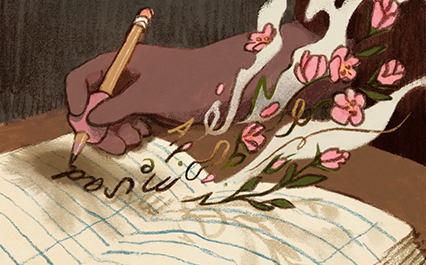Page Content

ILLUSTRATION BY DOROTHY LEUNG
It’s not the experience of what happened to a person that causes trauma—it’s their personal story that matters. It’s what they replay and can’t let go.
—Erin Luong, school counsellor
Teachers can identify signs of trauma and support refugee students
Rim Younis stopped going to school regularly in Grade 2 when her parents fled their home in Syria.
After a few years in Turkey, she arrived in Canada at 10 years old with her parents and four siblings as part of the Canadian government’s program to resettle Syrian refugees. Upon starting school in Calgary, she kept her head down in class, too nervous to make eye contact. “I just wouldn’t feel comfortable,” says Younis, now 14 and in Grade 10.
What she didn’t say to anyone was that she feared teachers. In Syria, students could be hurt for being late, getting an answer incorrect or speaking out of turn. One teacher, as a punishment, placed pencils in between each of Rim’s fingers and then squeezed her hand.
Younis credits time, support and one particular teacher with helping her learn to feel safe at school.
Younis told this teacher privately that she felt numb all the time—she couldn’t feel anger, happiness or sadness. The next day, the teacher brought her a journal and said Younis could write about how she felt at home and at school. “I would write in it and give to her. She would read it and write her comments back to me,” Younis said.
Almost universally, teachers become the most important people in the lives of refugee children outside of their immediate families, according to Annalee Coakley, the medical director of the Mosaic Refugee Health Centre in Calgary. “Not only are they the people teaching them science and language, but they’re their mentors and their guides in interpersonal relationships.”
Many refugee children have experienced or witnessed extreme trauma—including war, missing family members, poverty, violence and upheaval. Studies have shown that refugee children have high levels of PTSD, depression, anxiety and traumatic grief.
Not every child who has experienced trauma will suffer long-term psychological effects, says Erin Luong, a Calgary-based school counsellor and president of the ATA’s Council of School Counsellors.
“It’s not the experience of what happened to a person that causes trauma—it’s their personal story that matters. It’s what they replay and can’t let go,” she said.
She urged teachers to learn about a student’s personal background. “The more we get to know our kids’ stories without labelling it as being trauma, the easier it’s going to be to support those kids.”
Cultural factors may explain some of their behaviour in the classroom, said Luong. For example, kids who’ve relocated frequently for safety might move around a classroom when they feel unsafe. Those who’ve lived in refugee camps might collect items from other people’s desks because they have had limited experience with personal property, she said.
Luong said kids who are suffering from the effects of trauma can’t be treated by a teacher or school counsellors without specialized training, but teachers play a critical role in identifying and supporting kids.
“Our role at a school is to notice the signs and symptoms and connect those families with agencies that specialize in that type of support,” she said.
Signs of prolonged reaction to trauma can vary, says Mary Frances Fitzgerald, a counsellor and education consultant for diversity and mental health at Edmonton Public Schools. Some children and youth struggling with trauma will display overabundant behaviour, but more will fall into silence and lethargy. Many refugee children become overly compliant because, in their past, disobedience may have been met with violence, Fitzgerald said. Sometimes, they fall into silence, which can be the result of both trauma and language barriers.
“But a teacher should be attuned to picking
up signals. Most teachers can understand the dazed look that differs from the engaged look,” Fitzgerald said.
Coakley said teachers in Alberta have shown remarkable sensitivity and dedication in helping refugee children who have arrived here over the last five years.
Many kids who struggled with trauma and mental health issues have developed healthy relationships and set personal goals after they become comfortable at school, she said. “Being in school is the best form of trauma therapy for kids.”
Coakley urges teachers to be on high alert for refugee students who retreat into themselves.
“They’re the quiet child in the back of the classroom and they’re not terribly engaged,”
she said. “Those are ones I worry most about.”
Alberta resettled more than 8,600 refugees aged 17 and under between January 2015 and October 2019, according to statistics from Immigration, Refugees and Citizenship Canada.
